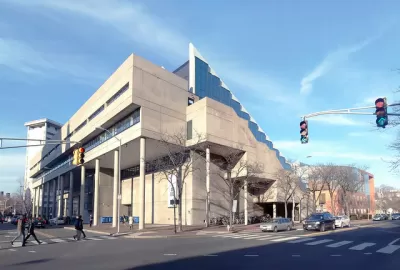Students investigating options often ask if it makes a difference where the planning school is located. The short answer is it matters less to students than many think.

For those wanting to enter graduate school in 2013, applications will soon be due. Students investigating options often ask if it makes a difference where the planning school is located-in a design school, a public policy college, or in other locations like colleges of agriculture or arts and sciences. The short answer is it matters less to students than many think.
Certainly there are some differences in some places. Planning programs in policy schools may require an extra quantitative methods class or two, some programs in design schools want an extra studio or project-based class, but there are many exceptions. In very small colleges with only two or three departments, administrators sometimes try to promote uniformity across programs in terms of curriculum. If the planning program is very small such requests can be hard to resist, particularly if other departments are large. But there is a great deal of self-governance among faculty. Further, even if there is a move for departments to have similarities it can be done through mechanisms such as conferences, joint competition entries, and other events that don't affect the main planning curriculum.
The Planning Accreditation Board makes the coursework and other requirements in accredited programs more uniform as well-about half a typical program is covering such material. Of course different departments do this in different ways but there is some consistency among accredited programs.
I think a bigger difference is between programs with small cores-where you have more chance to do electives and explore your own interests-and those with large cores where there is more of a uniform curriculum that all students go through. Both have strengths. I prefer small cores but understand the other perspective. To see if something is a small core see how many classes are really difficult to waive, and then how many other requirements there are. Small core programs tend to have 2-4 really-hard-to-waive classes and a core (excluding elective-heavy concentrations, internship requirements, exit project options, and the like) of under a year.
Another key difference, particularly relevant in small core programs, is the depth of urban and regional offerings across campus. Some planning programs are pretty much the only game in town in terms of urban and regional expertise on campus. In other universities there are many other departments where you might like to take classes and these may well be outside the college where the planning program is situated. Where a program is in a design school you will often find students crossing campus to public policy. If it is in an architecture school and landscape is in the agriculture college, then many planners find themselves in the ag school, and so on.
Dual degrees can give you a sense of the range of cross-campus connections. In some places there are lots of such connections and other places focus on the main planning degree. In addition, student groups--for example in international development, sustainability, or real estate--can show you how connected you might be within and outside the department.
The bottom line is to investigate programs individually. Faculty, particularly those who have served on curriculum committees and investigated other schools, may be well placed to give you advice. Not all faculty members have that expertise, however. You can do a lot of this yourself by comparing programs using online materials. The program you join, and the wider university that supports it, will matter more to you than the college or school it is part of.

Maui's Vacation Rental Debate Turns Ugly
Verbal attacks, misinformation campaigns and fistfights plague a high-stakes debate to convert thousands of vacation rentals into long-term housing.

Planetizen Federal Action Tracker
A weekly monitor of how Trump’s orders and actions are impacting planners and planning in America.

In Urban Planning, AI Prompting Could be the New Design Thinking
Creativity has long been key to great urban design. What if we see AI as our new creative partner?

King County Supportive Housing Program Offers Hope for Unhoused Residents
The county is taking a ‘Housing First’ approach that prioritizes getting people into housing, then offering wraparound supportive services.

Researchers Use AI to Get Clearer Picture of US Housing
Analysts are using artificial intelligence to supercharge their research by allowing them to comb through data faster. Though these AI tools can be error prone, they save time and housing researchers are optimistic about the future.

Making Shared Micromobility More Inclusive
Cities and shared mobility system operators can do more to include people with disabilities in planning and operations, per a new report.
Urban Design for Planners 1: Software Tools
This six-course series explores essential urban design concepts using open source software and equips planners with the tools they need to participate fully in the urban design process.
Planning for Universal Design
Learn the tools for implementing Universal Design in planning regulations.
planning NEXT
Appalachian Highlands Housing Partners
Mpact (founded as Rail~Volution)
City of Camden Redevelopment Agency
City of Astoria
City of Portland
City of Laramie






























